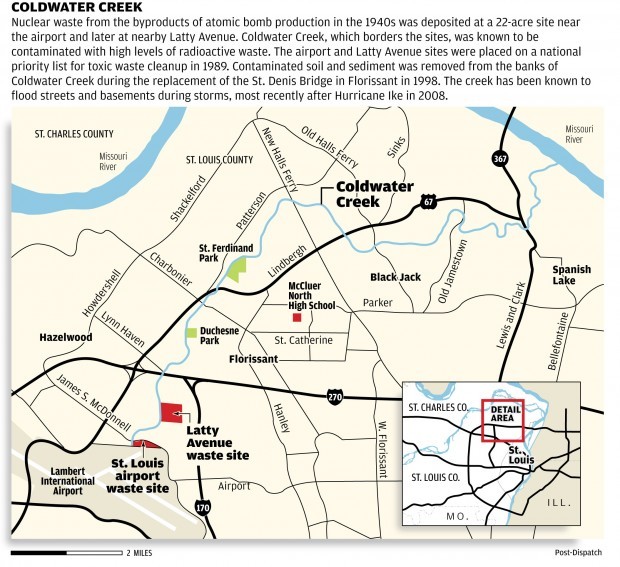On this page:
- Downtown St. Louis Site
- Coldwater Creek (St. Louis Airport & Latty Avenue Sites)
- Resources
The United States Army Corps of Engineers is responsible for the radioactive cleanup of nuclear weapons contamination at sites around the country through what is called the Formerly Utilized Sites Remedial Action Program (FUSRAP). As noted in our brief history of radioactivity in metro-St. Louis, FUSRAP is responsible for the cleanup and disposal of radioactive contamination found at several sites throughout our region.
Downtown St. Louis Site
This is where the radioactive legacy of the St. Louis region begins. In 1942, Mallinckrodt Chemical Works (MCW) agreed to process uranium for the Manhattan Project. It only took MCW about 50 days to successfully process uranium at a commercial scale for the first time in human history. Uranium processed at this site was used in the first self-sustained nuclear chain reaction at the University of Chicago on December 2, 1942. The MCW area was utilized for uranium processing from 1942-1957 before moving its operations to Weldon Spring in St. Charles County, Missouri. FUSRAP continues to work on removing the remainder of the accessible radioactive material it can find in this area.
Coldwater Creek
Coldwater Creek originates south of the St. Louis Airport and flows north through St. Louis County before meeting the Missouri River, just upstream the confluence with with the Mississippi River. Coldwater Creek was contaminated when radioactive material was moved from MCW downtown site to the St. Louis Airport site beginning in 1946. In 1966, radioactive material from the airport was sold by the federal government to a private corporation because there was value in the remaining material after U-235 was extracted for the creation of nuclear weapons. The material was moved north of the St. Louis Airport site to Latty Avenue in Hazelwood, also along Coldwater Creek. Some of the radioactive material from the Latty Avenue site was dumped at West Lake Landfill in 1973 without government authorization. The St. Louis Airport and Latty Avenue sites are the two points of entry for radioactive contamination into Coldwater Creek.

Resources
There is an incredible amount of information and resources available related to Coldwater Creek. MCE hopes the following information is helpful for better understanding the history, environment, and human impact that radioactive contamination has had on the region.
- Coldwater Creek – Just the Facts: This is a group of concerned citizens who grew up in north St. Louis County and grew concerned about why some of them, their family, and friends were being diagnosed with unusual cancers, autoimmune diseases, birth defects, and other diseases. They launched a health survey to get more information from others to demonstrate there is a problem that needed further investigation. Their efforts compelled the Agency for Toxic Substances and Disease Registry (ATSDR) to investigate exposure risks for people who lived, worked, and played along Coldwater Creek. Their efforts also compelled FUSRAP to further investigate radioactive contamination in areas that previously flooded and north of Highway 270. MCE recognized their contributions to the region by awarding the group the R. Roger Pryor Citizen Activist Award in 2013.
- St. Louis Army Corps of Engineers – FUSRAP: Cleanup activities started in 1990 under the DOE and transferred to Corps of Engineers by Congress in 1997. The FUSRAP mission is expected to last at least another decade in St. Louis. There is a lot of information on the history, health and safety, laws and regulations, public participation, and a variety of technical documents on the FUSRAP website.
- Agency for Toxic Substances and Disease Registry: The ATSDR performed a Public Health Assessment (PHA) that evaluates human health risks related to radioactive contamination at Coldwater Creek. One of the conclusions from the PHA includes that contamination in and around Coldwater Creek could have increased the risk of some types of cancers in people who played or lived in the area prior to remediation activities. (June 2018)
- Health Advisory: Report of Coldwater Creek Community Exposures Released is a document sent by the St. Louis County Department of Public Health and ATSDR to registered physicians in the St. Louis area to give them information on how to address patients’ concerns related to radiological exposure from Coldwater Creek. (June 2018)
- A Legacy of Environmental Health Concerns in St. Louis by Faisal Khan, MBBS, MPH, Director of the St. Louis County Department of Public Health (November 30, 2015)
- St. Louis Sites Remediation Task Force Report (September 1996). Our Executive Director, Roger Prior, was a member of the task force as well as several members of Missouri Coalition for the Environment.
